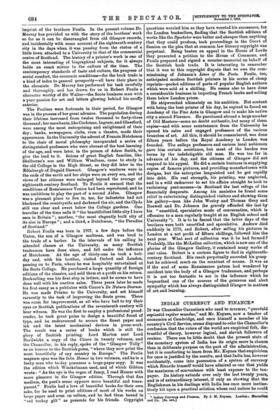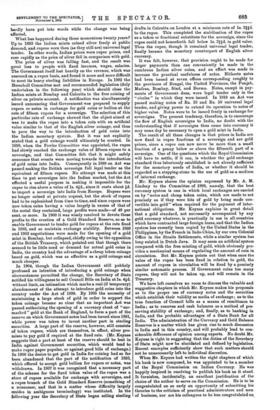INDIAN CURRENCY AND FINANCE.*
IT was Chancellor Oxenstiern who used to murmur, "quantulci. sapien.tici regitur mundus," and Mr. Keynes, now a teacher of economics at Cambridge, and once himself a member of his country's Civil Service, seems disposed to echo the Chancellor's confession that the rulers of the world are empirical folk, dis- trustful of theory, however logical, and slavish followers of routine. There can be little doubt that the present state of the monetary system of India has its origin more in chance than in deliberate purpose on the part of the administration, but it is comforting to learn from Mr. Keynes that empiricism for once is justified by the results, and that India has, however accidentally, come into possession of a system of currency which Ricardo himself would have admired as one that yields the maximum of convenience with least expense to the tax. payer. Its history extends over only the last twenty years, and is of extraordinary interest, if only as showing that the Englishman in his dealings with India has once more instinc- tively hit upon a practical solution whose real nature he could
By J. M. Keynes. London: Macmillan
hardly have put into words while the change was being effected.
What has happened during these momentous twenty years P Up to 1893 the Indian mints coined silver freely at public demand, and rupees were then (as they still are) universal legal tender. In other words, Indian prices were rupee prices, and rose rapidly as the price of silver fell in comparison with gold.
The price of silver was falling fast, and the result was great loss to people with fixed incomes, wages, salaries. The Government itself lost heavily on the revenue, which was assessed on a rupee basis, and found it more and more difficult to meet its heavy sterling liabilities in Europe. In 1892 the Herschel! Committee met and recommended legislation (duly undertaken in the following year) which should close the Indian mints at Bombay and Calcutta to the free coining of silver on private account. A notification was simultaneously issued announcing that Government was prepared to supply rupees or notes in exchange for gold coins or bullion at the rate of fifteen rupees for a sovereign. The selection of this particular rate of exchange showed that the object aimed at was to make the rupee into a token coin with an artificial value similar to that of the English silver coinage, and thus to pave the way to the introduction of gold coins into the Indian monetary system. But it was not explicitly stated that a gold coinage would ultimately be created. In 1898, when the Fowler Committee was appointed, the rupee bad slowly reached the exchange value of fifteen rupees to a sovereign, and that Committee felt that it might safely announce that events were moving towards the introduction of gold coins into India. Consequently in 1899 an Act was passed making the British sovereign full legal tender as the equivalent of fifteen rupees. No attempt was made at this time to put sovereigns into ,the Indian market, but the Act effected a useful purpose in making it impossible for the rupee to rise above a value of is. 4gd., since it costs about id. to import a sovereign into India from Europe. Rupees were no longer coined at private request, but the stock of rupees had to be replenished from time to time, and since rupees were now token coins having a value largely in excess of that of the metal they contained, large profits were made—of 40 per cent. or more. In 1900 it was wisely resolved to devote these profits to the creation of a Gold Standard Reserve, so as to enable Government to tender gold for rupees at the rate fixed in 1893, and so maintain exchange stability. Between 1899 and 1903 negotiations were made for the opening of a gold mint in Bombay, but collapsed, chiefly owing to the opposition of the British Treasury, which pointed out that though there seemed to be little need or demand for actual gold coins in India, the country had the advantage of a cheap token coinage based on gold, which was as effective as a gold coinage and much cheaper.
In 1904, though the Indian Government still publicly professed an intention of introducing a gold coinage when circumstances permitted the change, the Secretary of State notified his willingness to sell Council Bills on India at is. 4id. without limit, an intimation which marks a real (if temporary) abandonment of the attempt to introduce gold coins into the country under the Act of 1899. By 1905 the necessity of maintaining a large stock of gold in order to support the token coinage became so clear that an important Act was passed authorizing the opening of a currency chest of " ear- marked " gold at the Bank of England, to form a part of the reserve on which Government notes had been issued since 1861, while power was taken to invest another part in sterling securities. A large part of the reserve, however, still consists of token rupees, which are themselves, in effect, silver pro.. raises to pay gold if required at the fixed rate. (Mr. Keynes suggests that a part at least of the reserve should be lent in India against Government securities, which would tend to make rupee paper popular, or against good bills of exchange.) In 1906 the desire to get gold in India for coining had so far been abandoned that the part of the notification of 1893, which offered to accept gold bullion for rupees or notes, was withdrawn. In 1907 it was recognized that a necessary part of the scheme for the fixed token value of the rupee was a store of rupees available for exchange with sovereigns, and a rupee branch of the Gold Standard Reserve (something of a misnomer, and that in a matter whose difficulty largely resides in ambiguous terminology) was instituted. In the following year the Secretary of State began selling sterling
drafts in Calcutta on London at a minimum rate of Is. 311d. to the rupee. This completed the stabilisation of the rupee
as a token or fractional substitute for the sovereign, since the rupee could not henceforth fall below is. and. in gold value. Thus the rupee, though it remained universal legal tender, finally became the monetary counterpart of English silver currency.
It was felt, however, that provision ought to be made for larger payments than can conveniently be made in the cumbrous Indian silver coins, and an effort was made to increase the practical usefulness of notes. Hitherto notes had been issued at seven offices corresponding roughly to the provinces of Bengal, the United Provinces, the Punjab, Madras, Bombay, Sind, and Burma. Notes, except in pay- ments of Government dues, were legal tender only in the " circles " in which they were issued. In 1910 an Act was passed making notes of Rs. 10 and Rs. 50 universal legal tender, and giving power to extend its operation to notes of higher value. Notes were to be issued freely in exchange for sovereigns. The present tendency, therefore, is to encourage the flow of English sovereigns to India, no doubt with the understanding that if sovereigns thus come into currency it may some day be necessary to open a gold mint in India.
The result of all these changes is that prices in India are now fixed in rupee fractions of a sovereign and are gold prices, since a rupee can now never be more than a small fraction of a penny below or above the fifteenth part of a sovereign. One of the questions which the Royal Commission will have to settle, if it can, is whether the gold exchange standard thus laboriously established is not already sufficient for the monetary needs of India, or whether it should be regarded as a stepping-stone to the use of gold as a medium of internal exchange.
Mr. Keynes shares the opinion expressed by Mr. A. M. Lindsay to the Committee of 1898, namely, that the best currency system is one in which local exchanges are carried on by "notes and cheap token coins, which are made to act precisely as if they were bits of gold by being made con- vertible into gold" when required for the payment of inter- national obligations. Mr. Keynes explains in great detail that a gold standard, not necessarily accompanied by any gold currency whatever, is practically in use in all countries which have contracted large foreign loans, and that the Indian system has recently been copied by the United States in the Philippines, by the French in Indo-China, by our own Colonial Office in the Straits Settlements, while a similar system has long existed in Dutch Java. It may seem an artificial system compared with the free minting of gold, which obviously pro-
vides a mechanical means of regulating the amount of Coin in circulation. But Mr. Keynes points out that when once the
value of the rupee has been fixed in relation to gold, the amount of rupees in circulation will be fixed by a precisely similar automatic process. If Government coins too many rupees, they will not be taken up, and will remain in the Treasury.
We have left ourselves no room to discuss the valuable and suggestive chapters in which Mr. Keynes makes his proposals as to the proper use of currency notes and the securities which establish their validity as media of exchange; as to the true function of Council bills as a means of remittance to India ; as to reserves and cash balances as a method of pre- serving stability of exchange; and, finally, as to banking in India, and the probable advantages of a State Bank for all India. The administration of the Currency and Gold Balance Reserves is a matter which has given rise to much discussion in India and in this country, and will probably lead to con- siderable difference of opinion among experts. No doubt Mr.
Keynes is right in suggesting that the duties of the Secretary of State might now be elucidated and defined by legislation. Recent examples sufficiently show that such matters should not be unnecessarily left to individual discretion.
When Mr. Keynes had written the eight chapters of which his book is now composed, he was appointed to be a member of the Royal Commission on Indian Currency. He was happily inspired in resolving to publish his book as it stood. It furnishes, incidentally, an excellent justification of the choice of the author to serve on the Commission. He is to be congratulated on so early an opportunity of submitting his theories to the criticism of practised administrators and men of business, nor are his colleagues to be less congratulated on
having the help of a theorist who keeps an open mind and is fully aware that monetary developments must be adapted to the habits and even to the prejudices of ordinary men. Mr. Keynes will probably have little difficulty in convincing his colleagues that, though the Indian administration has hit upon a practical form of the Gold-Exchange Standard, yet "in her banking arrangements, in the management of her note system, and in the relations of her Government to the Money Market," India occupies an anomalous situation, and has much to learn from the experience of other countries. Mr. Keynes's experi- ence as a teacher of economics has no doubt helped him to state his arguments with admirable consideration for the needs of the inexperienced reader, and the result is a book whose inevitable difficulties are not increased by careless arrangement or a want of lucidity. His careful and disinterested study of the monetary facts of twenty years, and his methodical mar- shalling of facts and figures, will be useful even to those—and they will probably be few—who are not convinced by his reasoning.
































































 Previous page
Previous page